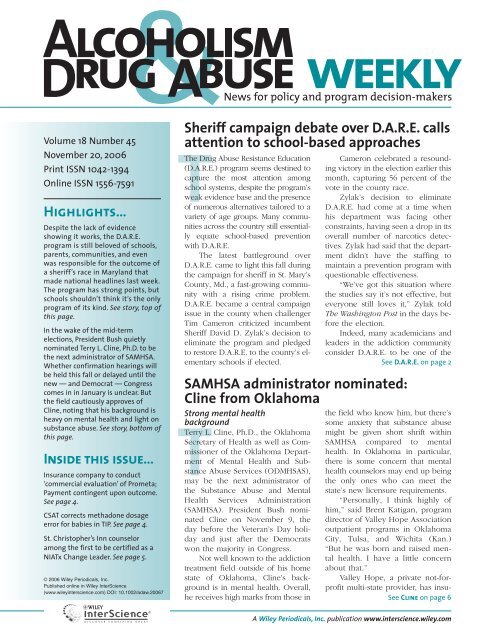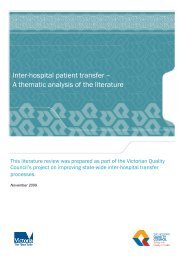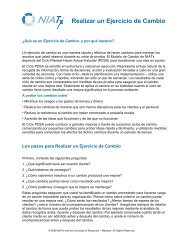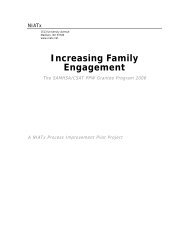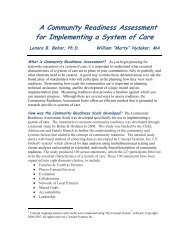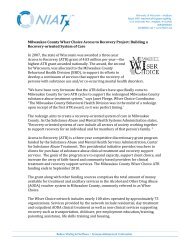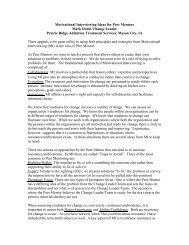St. Christopher's Inn counselor among the first to be certified ... - NIATx
St. Christopher's Inn counselor among the first to be certified ... - NIATx
St. Christopher's Inn counselor among the first to be certified ... - NIATx
You also want an ePaper? Increase the reach of your titles
YUMPU automatically turns print PDFs into web optimized ePapers that Google loves.
Volume 18 Num<strong>be</strong>r 45<br />
Novem<strong>be</strong>r 20, 2006<br />
Print ISSN 1042-1394<br />
Online ISSN 1556-7591<br />
Highlights…<br />
Despite <strong>the</strong> lack of evidence<br />
showing it works, <strong>the</strong> D.A.R.E.<br />
program is still <strong>be</strong>loved of schools,<br />
parents, communities, and even<br />
was responsible for <strong>the</strong> outcome of<br />
a sheriff’s race in Maryland that<br />
made national headlines last week.<br />
The program has strong points, but<br />
schools shouldn’t think it’s <strong>the</strong> only<br />
program of its kind. See s<strong>to</strong>ry, <strong>to</strong>p of<br />
this page.<br />
In <strong>the</strong> wake of <strong>the</strong> mid-term<br />
elections, President Bush quietly<br />
nominated Terry L. Cline, Ph.D. <strong>to</strong> <strong>be</strong><br />
<strong>the</strong> next administra<strong>to</strong>r of SAMHSA.<br />
Whe<strong>the</strong>r confirmation hearings will<br />
<strong>be</strong> held this fall or delayed until <strong>the</strong><br />
new — and Democrat — Congress<br />
comes in in January is unclear. But<br />
<strong>the</strong> field cautiously approves of<br />
Cline, noting that his background is<br />
heavy on mental health and light on<br />
substance abuse. See s<strong>to</strong>ry, bot<strong>to</strong>m of<br />
this page.<br />
Inside this issue…<br />
Insurance company <strong>to</strong> conduct<br />
‘commercial evaluation’ of Prometa;<br />
Payment contingent upon outcome.<br />
See page 4.<br />
CSAT corrects methadone dosage<br />
error for babies in TIP. See page 4.<br />
<strong>St</strong>. Chris<strong>to</strong>pher’s <strong>Inn</strong> <strong>counselor</strong><br />
<strong>among</strong> <strong>the</strong> <strong>first</strong> <strong>to</strong> <strong>be</strong> <strong>certified</strong> as a<br />
<strong>NIATx</strong> Change Leader. See page 5.<br />
© 2006 Wiley Periodicals, Inc.<br />
Published online in Wiley InterScience<br />
(www.wileyinterscience.com) DOI: 10.1002/adaw.20067<br />
Sheriff campaign debate over D.A.R.E. calls<br />
attention <strong>to</strong> school-based approaches<br />
The Drug Abuse Resistance Education<br />
(D.A.R.E.) program seems destined <strong>to</strong><br />
capture <strong>the</strong> most attention <strong>among</strong><br />
school systems, despite <strong>the</strong> program’s<br />
weak evidence base and <strong>the</strong> presence Tof numerous alternatives tailored <strong>to</strong> a<br />
variety of age groups. Many communities<br />
across <strong>the</strong> country still essentially<br />
equate school-based prevention<br />
with D.A.R.E.<br />
The latest battleground over<br />
D.A.R.E. came <strong>to</strong> light this fall during<br />
<strong>the</strong> campaign for sheriff in <strong>St</strong>. Mary’s<br />
County, Md., a fast-growing community<br />
with a rising crime problem.<br />
D.A.R.E. <strong>be</strong>came a central campaign<br />
issue in <strong>the</strong> county when challenger<br />
Tim Cameron criticized incum<strong>be</strong>nt<br />
Sheriff David D. Zylak’s decision <strong>to</strong><br />
eliminate <strong>the</strong> program and pledged<br />
<strong>to</strong> res<strong>to</strong>re D.A.R.E. <strong>to</strong> <strong>the</strong> county’s elementary<br />
schools if elected.<br />
Cameron celebrated a resounding<br />
vic<strong>to</strong>ry in <strong>the</strong> election earlier this<br />
month, capturing 56 percent of <strong>the</strong><br />
vote in <strong>the</strong> county race.<br />
Zylak’s decision <strong>to</strong> eliminate<br />
D.A.R.E. had come at a time when<br />
his department was facing o<strong>the</strong>r<br />
constraints, having seen a drop in its<br />
overall num<strong>be</strong>r of narcotics detectives.<br />
Zylak had said that <strong>the</strong> department<br />
didn’t have <strong>the</strong> staffing <strong>to</strong><br />
maintain a prevention program with<br />
questionable effectiveness.<br />
“We’ve got this situation where<br />
<strong>the</strong> studies say it’s not effective, but<br />
everyone still loves it,” Zylak <strong>to</strong>ld<br />
The Washing<strong>to</strong>n Post in <strong>the</strong> days <strong>be</strong>fore<br />
<strong>the</strong> election.<br />
Indeed, many academicians and<br />
leaders in <strong>the</strong> addiction community<br />
consider D.A.R.E. <strong>to</strong> <strong>be</strong> one of <strong>the</strong><br />
See D.A.R.E. on page 2<br />
SAMHSA administra<strong>to</strong>r nominated:<br />
Cline from Oklahoma<br />
<strong>St</strong>rong mental health <br />
background<br />
Terry L. Cline, Ph.D., <strong>the</strong> Oklahoma<br />
Secretary of Health as well as Commissioner<br />
of <strong>the</strong> Oklahoma Department<br />
of Mental Health and Substance<br />
Abuse Services (ODMHSAS), Tmay <strong>be</strong> <strong>the</strong> next administra<strong>to</strong>r of<br />
<strong>the</strong> Substance Abuse and Mental<br />
Health Services Administration<br />
(SAMHSA). President Bush nominated<br />
Cline on Novem<strong>be</strong>r 9, <strong>the</strong><br />
day <strong>be</strong>fore <strong>the</strong> Veteran’s Day holiday<br />
and just after <strong>the</strong> Democrats<br />
won <strong>the</strong> majority in Congress.<br />
Not well known <strong>to</strong> <strong>the</strong> addiction<br />
treatment field outside of his home<br />
state of Oklahoma, Cline’s background<br />
is in mental health. Overall,<br />
he receives high marks from those in<br />
<strong>the</strong> field who know him, but <strong>the</strong>re’s<br />
some anxiety that substance abuse<br />
might <strong>be</strong> given short shrift within<br />
SAMHSA compared <strong>to</strong> mental<br />
health. In Oklahoma in particular,<br />
<strong>the</strong>re is some concern that mental<br />
health <strong>counselor</strong>s may end up <strong>be</strong>ing<br />
<strong>the</strong> only ones who can meet <strong>the</strong><br />
state’s new licensure requirements.<br />
“Personally, I think highly of<br />
him,” said Brent Katigan, program<br />
direc<strong>to</strong>r of Valley Hope Association<br />
outpatient programs in Oklahoma<br />
City, Tulsa, and Wichita (Kan.)<br />
“But he was born and raised mental<br />
health. I have a little concern<br />
about that.”<br />
Valley Hope, a private not-forprofit<br />
multi-state provider, has insu-<br />
See Cline on page 6<br />
A Wiley Periodicals, Inc. publication www.interscience.wiley.com
2<br />
Alcoholism & Drug Abuse Weekly Novem<strong>be</strong>r 20, 2006<br />
D.A.R.E. from page 1<br />
weakest options for school systems<br />
<strong>to</strong> embrace on a purely evidence-focused<br />
basis. “The shame with<br />
D.A.R.E. is <strong>the</strong>re has never <strong>be</strong>en a<br />
published scientific article that has<br />
demonstrated its effectiveness,”<br />
David J. Hanson, professor emeritus<br />
at <strong>the</strong> <strong>St</strong>ate University of New York at<br />
Potsdam and frequent critic of a variety<br />
of conventional approaches in<br />
addiction services, <strong>to</strong>ld ADAW. “It’s<br />
really not even a debatable matter.”<br />
Yet while many might criticize<br />
policy-makers’ decision <strong>to</strong> continue<br />
<strong>to</strong> embrace D.A.R.E. (<strong>the</strong> Post reported<br />
that only three Maryland<br />
counties do not use <strong>the</strong> police-run<br />
program in <strong>the</strong>ir elementary<br />
schools), o<strong>the</strong>rs counter that<br />
D.A.R.E.’s opponents use incomplete<br />
analyses and subject <strong>the</strong> program<br />
<strong>to</strong> expectations that no prevention<br />
effort could meet.<br />
Even at <strong>the</strong> highest level of <strong>the</strong><br />
national prevention infrastructure,<br />
<strong>the</strong>re are voices that insist that a comprehensive<br />
approach <strong>to</strong> prevention<br />
in local communities can and should<br />
include efforts such as D.A.R.E.<br />
“Not a single program can do<br />
what needs <strong>to</strong> <strong>be</strong> done by itself; not<br />
one,” Beverly Watts Davis, direc<strong>to</strong>r<br />
of <strong>the</strong> federal Center for Substance<br />
Abuse Prevention (CSAP), <strong>to</strong>ld<br />
ADAW. Watts Davis added that in<br />
some high-crime communities,<br />
D.A.R.E. has <strong>be</strong>en essential <strong>to</strong> creating<br />
an environment conducive <strong>to</strong><br />
learning and positive accomplishment<br />
<strong>among</strong> students.<br />
“What D.A.R.E. brought <strong>to</strong> <strong>the</strong>se<br />
communities was some sense of<br />
order in <strong>the</strong> classroom that allowed<br />
young people <strong>to</strong> learn,” Watts Davis<br />
said. Asked if that was a legitimate<br />
enough reason <strong>to</strong> use <strong>the</strong> controversial<br />
program, she replied, “It’s legitimate<br />
enough for that community.”<br />
Schools’ analysis<br />
Watts Davis, who <strong>be</strong>fore joining<br />
SAMHSA directed a community antidrug<br />
coalition in San An<strong>to</strong>nio,<br />
Texas, <strong>be</strong>lieves communities and<br />
school districts often ask <strong>the</strong> wrong<br />
questions about prevention strategies<br />
and don’t do an effective job<br />
matching approaches <strong>to</strong> <strong>the</strong>ir distinct<br />
problems.<br />
“The most important thing a<br />
school district should do is take a<br />
look at what <strong>the</strong> [local] data tells it,”<br />
Watts Davis said. Too often a district,<br />
for example, will see that<br />
drunk-driving episodes involving<br />
new teen drivers have <strong>be</strong>come a<br />
prevalent problem, but <strong>the</strong>n will<br />
turn its attention <strong>to</strong> implementing a<br />
men<strong>to</strong>ring program for elementary<br />
school students instead of tackling<br />
<strong>the</strong> documented problem head on,<br />
she said.<br />
Often this occurs <strong>be</strong>cause fac<strong>to</strong>rs<br />
such as program costs and<br />
scheduling constraints in <strong>the</strong> school<br />
day get in <strong>the</strong> way of making completely<br />
objective decisions about<br />
prevention strategies, Watts Davis<br />
said. “The federal government has<br />
<strong>to</strong> recognize this; it’s what I call <strong>the</strong><br />
‘reality fac<strong>to</strong>r,’” she said.<br />
In response <strong>to</strong> <strong>the</strong> limitations<br />
school systems and communities<br />
face, CSAP’s parent agency, <strong>the</strong> Substance<br />
Abuse and Mental Health<br />
Services Administration (SAMHSA),<br />
has <strong>be</strong>gun acquiring planning <strong>to</strong>ols<br />
and making <strong>the</strong>m available in <strong>the</strong><br />
public domain. Last month SAMHSA<br />
announced <strong>the</strong> availability of Communities<br />
That Care, a prevention<br />
planning system that previously had<br />
<strong>be</strong>en owned by a private provider<br />
(see ADAW, Oct. 30).<br />
Watts Davis said she would like<br />
<strong>to</strong> see <strong>the</strong> federal government take<br />
ownership of more of <strong>the</strong>se <strong>to</strong>ols<br />
for communities so that <strong>the</strong>y can <strong>be</strong><br />
more widely used free of charge.<br />
Watts Davis <strong>be</strong>lieves it is certainly<br />
important for communities <strong>to</strong><br />
consider evidence-based approaches<br />
<strong>to</strong> prevention, but warns that <strong>the</strong><br />
evidence is found in more places<br />
than just with researchers on whom<br />
million-dollar grants are <strong>be</strong>s<strong>to</strong>wed.<br />
She consistently says <strong>to</strong> local leaders,<br />
“Do not devalue your ability <strong>to</strong><br />
come up with evidence-based practices,”<br />
adding, “Local people solve<br />
local problems <strong>be</strong>st.”<br />
And she says that when communities<br />
are looking at what <strong>the</strong> evi-<br />
Executive Edi<strong>to</strong>r: Karienne <strong>St</strong>ovell<br />
Edi<strong>to</strong>r: Alison Knopf<br />
Contributing Edi<strong>to</strong>r: Gary Enos<br />
Associate Edi<strong>to</strong>r: Sarah Merrill<br />
Production: Kevin DeYoung<br />
Edi<strong>to</strong>rial Direc<strong>to</strong>r: Jo-Ann Wasserman<br />
Publisher: Sue Lewis<br />
To renew your subscription, contact Subscription Distribution US, c/o John<br />
Wiley & Sons, Inc., 111 River <strong>St</strong>reet, Hoboken, NJ 07030-5774; (201) 748-6645;<br />
e-mail: subinfo@wiley.com.<br />
Alcoholism & Drug Abuse Weekly (Print ISSN 1042-1394; Online ISSN 1556<br />
7591) is an independent newsletter meeting <strong>the</strong> information needs of all<br />
alcoholism and drug abuse professionals, providing timely reports on national<br />
trends and developments in funding, policy, prevention, treatment<br />
and research in alcohol and drug abuse, and also covering issues on certification,<br />
reimbursement and o<strong>the</strong>r news of importance <strong>to</strong> public, private<br />
nonprofit and for-profit treatment agencies. Published every week except<br />
for <strong>the</strong> <strong>first</strong> Monday in July, <strong>the</strong> <strong>first</strong> Monday in Septem<strong>be</strong>r, <strong>the</strong> last Monday<br />
in Novem<strong>be</strong>r and <strong>the</strong> last Monday in Decem<strong>be</strong>r. The yearly subscription<br />
rate for Alcoholism & Drug Abuse Weekly is $699. Alcoholism & Drug<br />
Abuse Weekly accepts no advertising and is supported solely by its readers.<br />
For address changes or new subscriptions, contact Subscription Distribution<br />
US, c/o John Wiley & Sons, Inc., 111 River <strong>St</strong>reet, Hoboken, NJ 07030<br />
5774; (201) 748-6645; e-mail: subinfo@wiley.com. © 2006 Wiley Periodicals,<br />
Inc., a Wiley Company. All rights reserved. Reproduction in any form<br />
without <strong>the</strong> consent of <strong>the</strong> publisher is strictly forbidden. For reprint permission,<br />
call (201) 748-6011.<br />
Business and Edi<strong>to</strong>rial Offices: John Wiley & Sons, Inc., 111 River <strong>St</strong>reet,<br />
Hoboken, NJ 07030-5774; Alison Knopf, e-mail: insinger@<strong>be</strong>stweb.net;<br />
(845) 225-2935.<br />
It is illegal under federal copyright law <strong>to</strong> reproduce this publication or any portion of it without <strong>the</strong> publisher’s permission Alcoholism & Drug Abuse Weekly DOI: 10.1002/adaw
Novem<strong>be</strong>r 20, 2006 Alcoholism & Drug Abuse Weekly<br />
3<br />
dence says, more fac<strong>to</strong>rs than simply<br />
<strong>the</strong> reduction of drug use <strong>among</strong><br />
young people need <strong>to</strong> <strong>be</strong> taken in<strong>to</strong><br />
consideration. “Some communities<br />
may want <strong>to</strong> encourage school and<br />
family bonding as well,” she said in<br />
citing an example of what could<br />
constitute a broader agenda.<br />
Plethora of options<br />
It is abundantly clear that no<br />
matter what a community thinks of<br />
D.A.R.E.’s effectiveness, no jurisdiction<br />
should <strong>be</strong> using it only <strong>be</strong>cause<br />
it thinks <strong>the</strong>re are no o<strong>the</strong>r options<br />
with a track record.<br />
Several government sources in<br />
recent years have issued documents<br />
listing a variety of school- and community-based<br />
prevention programs<br />
tailored <strong>to</strong> specific age groups or targeted<br />
<strong>to</strong> specific risk fac<strong>to</strong>rs for substance<br />
use. For example, <strong>the</strong> National<br />
Institute on Drug Abuse’s (NIDA’s)<br />
research-based guide entitled Preventing<br />
Drug Use Among Children<br />
and Adolescents includes an entire<br />
chapter of examples of researchbased<br />
prevention programs at each<br />
school level and for audience categories<br />
encompassing “universal,”<br />
“selective,” “indicated,” and “tiered.”<br />
Also, a 2006 joint publication<br />
of <strong>the</strong> National Institute on Alcohol<br />
Abuse and Alcoholism (NIAAA)<br />
and Community Anti-Drug Coalitions<br />
of America (CADCA), Using<br />
Science <strong>to</strong> Combat Underage<br />
Drinking, states, “The most comprehensive<br />
interventions <strong>to</strong> date<br />
have involved <strong>the</strong> coordination of<br />
efforts <strong>among</strong> schools, families,<br />
and <strong>the</strong> community at large.” The<br />
report, part of CADCA’s Practical<br />
Theorist series, uses <strong>the</strong> Project<br />
Northland effort in 22 nor<strong>the</strong>rn<br />
Minnesota school districts as an example<br />
of comprehensiveness, citing<br />
its work with school curricula,<br />
parental involvement and communitywide<br />
efforts <strong>to</strong> change norms<br />
about alcohol use.<br />
Several experts say this precisely<br />
is what is missing from D.A.R.E.,<br />
which generally focuses on only<br />
one elementary-school age group<br />
and doesn’t tend <strong>to</strong> venture <strong>be</strong>yond<br />
<strong>the</strong> outreach of a law enforcement<br />
officer <strong>to</strong> a group of young people.<br />
“The programs that work <strong>be</strong>st<br />
tend <strong>to</strong> <strong>be</strong> <strong>the</strong> ones that are most<br />
comprehensive, involving schools,<br />
parents, and <strong>the</strong> community,” Norman<br />
G. Hoffmann, Ph.D., president<br />
of Evince Clinical Assessments and a<br />
longtime evalua<strong>to</strong>r of treatment effectiveness,<br />
<strong>to</strong>ld ADAW. “They don’t<br />
just give it <strong>to</strong> <strong>the</strong> cops and let <strong>the</strong><br />
cops do it.”<br />
Hoffmann said research has<br />
shown that it is important <strong>to</strong> follow<br />
up lessons taught in <strong>the</strong> early school<br />
years at later stages, with age-specific<br />
approaches throughout <strong>the</strong><br />
school cycle. He added that most<br />
youths who <strong>be</strong>gin exhibiting substance<br />
use problems early have a<br />
variety of o<strong>the</strong>r problems as well,<br />
and that school-based programs<br />
should not lose sight of <strong>the</strong> need for<br />
broader intervention strategies for<br />
this troubled group.<br />
“It’s not that this group can’t say<br />
no [<strong>to</strong> drugs]; it’s that <strong>the</strong>y have no<br />
reason <strong>to</strong>,” said Hoffmann. Building<br />
self-esteem and decision-making<br />
skills is as essential as working on<br />
drug refusal skills when addressing<br />
youths who are already having<br />
problems, he said.<br />
Hanson said that <strong>be</strong>cause<br />
D.A.R.E. tends <strong>to</strong> <strong>be</strong> so popular with<br />
school officials, parents and police,<br />
<strong>the</strong> prevalent <strong>be</strong>lief in <strong>the</strong> program<br />
despite <strong>the</strong> lack of research evidence<br />
sustains its widespread use<br />
across <strong>the</strong> country. He did say that<br />
one documentable effect of D.A.R.E.<br />
is that youths who participate in <strong>the</strong><br />
program “tend <strong>to</strong> like police <strong>be</strong>tter.”<br />
Hanson <strong>be</strong>lieves that whatever<br />
prevention strategy a community<br />
adopts, leaders should always take<br />
an honest approach with young<br />
people. “They shouldn’t <strong>be</strong> using<br />
scare approaches, or ever <strong>be</strong> put in<br />
a position of not giving accurate information,”<br />
he said. •<br />
Decline in smoking rates by high schoolers has leveled off<br />
Youth smoking went down from 1997 <strong>to</strong> 2003, but <strong>the</strong> decline seems <strong>to</strong> have stalled, according <strong>to</strong> a<br />
recent CDC analysis of data from <strong>the</strong> national Youth Risk Behavior Survey.While <strong>the</strong> prevalence of current<br />
cigarette use declined significantly from 36.4 percent in 1997 <strong>to</strong> 21.9 percent in 2003, <strong>the</strong>re was<br />
no statistically significant difference in use from 2003 <strong>to</strong> 2005, which is consistent with trends observed<br />
in o<strong>the</strong>r national school-based surveys.<br />
100%<br />
80%<br />
60%<br />
40% 34.8% 36.4% 34.8%<br />
27.5%<br />
30.5% 28.5%<br />
20%<br />
0%<br />
21.9%<br />
23.0%<br />
1991 1993 1995 1997 1999 2001 2003 2005<br />
Source: Adapted by CESAR from Centers for Disease Control and Prevention (CDC), “Cigarette Use Among<br />
High School <strong>St</strong>udents—United <strong>St</strong>ates, 1991-2005,” Morbidity and Mortality Monthly Report 55(26)724<br />
726, 2006. Available online at http://www.cdc.gov/mmwr/preview/mmwrhtml/mm5526a2.htm.<br />
Alcoholism & Drug Abuse Weekly DOI: 10.1002/adaw<br />
A Wiley Periodicals, Inc. publication www.interscience.wiley.com
page 6.<br />
than prescri<strong>be</strong>d, cases when <strong>the</strong><br />
4<br />
Alcoholism & Drug Abuse Weekly Novem<strong>be</strong>r 20, 2006<br />
Insurance company <strong>to</strong> conduct ‘commercial evaluation’ of<br />
Prometa; Payment contingent upon outcome<br />
Hythiam and Horizon Blue Prometa based upon <strong>the</strong> specific improve <strong>the</strong> quality of care that<br />
Cross Blue Shield of New Jersey needs of our patients and cus- we provide <strong>to</strong> our mem<strong>be</strong>rship.<br />
(BCBSNJ) are joining <strong>to</strong>ge<strong>the</strong>r <strong>to</strong> <strong>to</strong>mers,” said Dr. Chris<strong>to</strong>pher Va- Additionally, Prometa will <strong>be</strong><br />
conduct a “commercial evaluation” lerian, Executive Medical Direc- evaluated for increases in trea<strong>to</strong>f<br />
Prometa, <strong>the</strong> $12,000-$15,000 <strong>to</strong>r, Quality and Clinical <strong>Inn</strong>ova- ment retention, reduction of a<br />
outpatient program <strong>to</strong> treat alco- tions, Horizon BCBSNJ. “Sub- patient’s time spent away from<br />
hol, methamphetamine, or cocaine stance dependent patients tend <strong>the</strong> workplace, and reduction of<br />
addiction. The outcomes will <strong>be</strong> <strong>to</strong> <strong>be</strong> high utilizers of a spectrum patient utilization of emergency<br />
measured at 90 days, “after which of health care services, and <strong>the</strong> medical care.”<br />
initial reimbursement may com- chronic relapsing nature of this For <strong>the</strong> evaluation, 50 BCBmence,”<br />
according <strong>to</strong> BCBSNJ. disease tends <strong>to</strong> result in signifi- SNJ patients will <strong>be</strong> treated with<br />
“Hythiam has <strong>be</strong>en very cant time off from work. A suc- Prometa pro<strong>to</strong>cols. Followup will<br />
open <strong>to</strong> having us evaluate cessful result in this pilot will extend through 6 months.<br />
CSAT corrects methadone dosage error for babies in TIP<br />
The Substance Abuse and Mental • Column 1, line 6 from <strong>the</strong> bot mg/mL morphine-equivalent;<br />
Health Services Administration’s Cen <strong>to</strong>m, reads “0.4 mg/kg/dose.” starting dosage, 0.4 mg/kg/day<br />
ter for Substance Abuse Treatment It should read “0.04 mg/kg/ orally in six <strong>to</strong> eight divided<br />
(CSAT) recently corrected two typo- dose.” doses [timed with <strong>the</strong> feeding<br />
graphical errors in <strong>the</strong> Treatment Im- In subsequent printings of TIP schedule]). Dosage is increased<br />
provement Pro<strong>to</strong>col (TIP) 43: Medica 43, page 219, <strong>the</strong> paragraphs re- by 0.04 mg/kg/dose until control<br />
tion-Assisted Treatment for Opioid garding this <strong>to</strong>pic have <strong>be</strong>en is achieved or a maximum of 2.0<br />
Addiction in Opioid Treatment Pro- changed <strong>to</strong> read: mg/kg/day is reached. If Neonagrams.<br />
These are serious typos which<br />
tal Abstinence Scores stay high<br />
need <strong>to</strong> <strong>be</strong> corrected, according <strong>to</strong> “If pharmacological management but daily dosage nears maximum,<br />
CSAT. The corrections are noted is indicated, several methods symp<strong>to</strong>ms are reassessed and<br />
<strong>be</strong>low as it appears in Chapter 13. have <strong>be</strong>en found useful. The concurrent phenobarbital <strong>the</strong>rapy<br />
In Treatment Improvement American Academy of Pediatrics considered. When control is<br />
Pro<strong>to</strong>col (TIP) 43: Medication-As- Committee on Drugs policy state- achieved, <strong>the</strong> dosage is continued<br />
sisted Treatment for Opioid Addic ment on Neonatal Drug With- for 72 hours <strong>be</strong>fore pharmacologtion<br />
in Opioid Treatment Programs drawal (1998) descri<strong>be</strong>s several ical weaning, in which dosages<br />
(2005 printing), Chapter 13, page agents for <strong>the</strong> treatment of NAS are decreased 10 percent daily or<br />
219, incorrect information about including methadone, tincture of as <strong>to</strong>lerated. When 0.2 mg/kg/day<br />
medication treatment for neonatal opium, paregoric, and morphine. is reached, medication may <strong>be</strong><br />
abstinence syndrome (NAS) was One method (J. Greenspan, s<strong>to</strong>pped. Decisions about dosage<br />
published. Thomas Jefferson University Hos decrease during pharmacological<br />
• Column 1, line 9 from <strong>the</strong> bot pital, Philadelphia, personal com weaning are based on Neonatal<br />
<strong>to</strong>m, reads “0.4 mg/kg/dose.” It munication, Oc<strong>to</strong><strong>be</strong>r 2006) uses Abstinence Scores, weight, and<br />
should read “0.4 mg/kg/day.” neonatal opium solution (0.4 physical exams.” •<br />
Volume 18 Num<strong>be</strong>r 38<br />
Oc<strong>to</strong><strong>be</strong>r 2, 2006<br />
Print ISSN 1042-1394<br />
Online ISSN 1556-7591<br />
Long a vital supporter of <strong>the</strong> field,<br />
<strong>the</strong> Ro<strong>be</strong>rt Wood Johnson<br />
Foundation wi l discontinue its<br />
addiction treatment and prevention<br />
portfolio, folding it in<strong>to</strong> “vulnerable<br />
populations.” The exten <strong>to</strong> which<br />
addiction programs wi l still <strong>be</strong><br />
eligible for grants depends on how<br />
<strong>the</strong> a plications fit in<strong>to</strong> <strong>the</strong> new<br />
program,which is sti l a “work in<br />
progre s.” S e s<strong>to</strong>ry, <strong>to</strong>p of this page.<br />
A new report spotlights <strong>the</strong> problems<br />
of co-o cu ring ADHD and substance<br />
abuse in adolescents. Young people<br />
may end up in <strong>the</strong> emergency<br />
department <strong>be</strong>cause of misuse of<br />
<strong>the</strong>se medications; some youths<br />
snor <strong>the</strong>m <strong>to</strong> get high.Some<br />
treatment providers do not allow<br />
new patients <strong>to</strong> <strong>be</strong> on <strong>the</strong>se<br />
stimulant medications, prefe ring <strong>to</strong><br />
wait and s e how <strong>the</strong> child does<br />
withou <strong>the</strong>m.Psychiatrists, however,<br />
say that untreated ADHD can<br />
increase <strong>the</strong> likelihood of substance<br />
abuse. S e s<strong>to</strong>ry, bo <strong>to</strong>m of this page.<br />
Grant project wi l s ek <strong>to</strong> link<br />
addiction,DD services. S e page 5.<br />
Maryland makes slow progre s in<br />
stre sing treatment over jail. See<br />
New grants for community-based<br />
programs treating adolescents and<br />
families. S e page 7.<br />
©2006 Wiley Periodicals, Inc.<br />
Published online in Wiley InterScience<br />
(www.wileyinterscience.com) DOI: 10.1 02/adaw.2 060<br />
RWJF <strong>to</strong> s<strong>to</strong>p funding addiction treatment<br />
and prevention: current grants <strong>to</strong> finish<br />
The Ro<strong>be</strong>rt Wood Johnson Foundation<br />
(RWJF), which supported addiction<br />
prevention and treatment<br />
with more than $18 mi lion last year<br />
is cutting that program out of its<br />
portfolio and shifting a l addiction<br />
funding in<strong>to</strong> its “vulnerable populations”<br />
category, ADAW has learned.<br />
Over <strong>the</strong> last 20 years, RWJF has<br />
given more than half a bi lion dollars<br />
<strong>to</strong> <strong>the</strong> addiction treatment and<br />
prevention field.<br />
There was no o ficial announcement<br />
of <strong>the</strong> change, which<br />
was decided at a July strategic<br />
planning meeting. On Septem<strong>be</strong>r<br />
21, a le ter went out <strong>to</strong> a l <strong>the</strong> addiction<br />
grantees from Risa Lavizzo-<br />
Mourey, RWJF president and CEO,<br />
advising <strong>the</strong>m of this change.<br />
The le ter said that RWJF had<br />
“determined that our new grantmaking<br />
related <strong>to</strong> addiction prevention<br />
and treatment wi l now <strong>be</strong> incorporated<br />
in<strong>to</strong> <strong>the</strong> foundation’s vulnerable<br />
populations portfolio,” spokeswoman<br />
Andrea Daitz confirmed.<br />
“We wi l honor and complete our<br />
grant commitments over <strong>the</strong> next<br />
several years but we do not envision<br />
making new investments in addiction<br />
outside of <strong>the</strong> vulnerable<br />
populations we are serving.”<br />
The Prince<strong>to</strong>n, N.J.-based<br />
foundation has <strong>be</strong>en a prominent<br />
supporter of addiction prevention<br />
and treatment for decades, and <strong>the</strong><br />
field is very concerned about what<br />
this will mean. Daitz stre sed that:<br />
ADHD medication misuse raises questions<br />
for treatment providers<br />
Against <strong>the</strong> backdrop of increasing for ADHD, such as a<strong>to</strong>moxetine<br />
abuse of prescription drugs comes a (<strong>St</strong>ra tera), are not stimulants, and<br />
report linking medications for a tention<br />
deficit/hyperactivity disorder According <strong>to</strong> <strong>the</strong> current Drug<br />
not addictive.<br />
(ADHD) <strong>to</strong> emergency room visits, Abuse Warning Network (DAWN)<br />
mostly due <strong>to</strong> nonmedical use of Report, Emergency Department Visits<br />
Involving ADHD <strong>St</strong>imulant Med<br />
<strong>the</strong>se drugs. This taps in<strong>to</strong> a longtime<br />
controversy about whe<strong>the</strong>r patients<br />
with addiction should <strong>be</strong> on gency departments in 2004 resulted<br />
ications, almost 8,000 visits <strong>to</strong> emer<br />
<strong>the</strong>se medications, which are contro<br />
led substances and addictive, es<br />
Nonmedical use a counted for 48<br />
from <strong>the</strong> use of <strong>the</strong>se medications.<br />
pecia ly when <strong>the</strong> pi ls are crushed percent of <strong>the</strong> visits, and medical<br />
and snorted.<br />
use a counted for 34 percent. Nonmedical<br />
use, a cording <strong>to</strong> <strong>the</strong> re<br />
The medications in question are<br />
methylphenidate (common trade port, includes: cases when <strong>the</strong> person<br />
<strong>to</strong>ok a dose that was higher<br />
names are Ritalin and Concerta),<br />
and amphetamine-dextroamphetamine<br />
(Adderal). O<strong>the</strong>r medications<br />
Tired of routing your subscription<br />
F or pricing on bulk subscriptions call Sandy Quade:<br />
203-643-8066<br />
A publication www. i nterscience.wiley. c o m<br />
It is illegal under federal copyright law <strong>to</strong> reproduce this publication or any portion of it without <strong>the</strong> publisher’s permission Alcoholism & Drug Abuse Weekly DOI: 10.1002/adaw
Novem<strong>be</strong>r 20, 2006 Alcoholism & Drug Abuse Weekly<br />
5<br />
<strong>St</strong>. Chris<strong>to</strong>pher’s <strong>Inn</strong> <strong>counselor</strong> <strong>among</strong> <strong>the</strong> <strong>first</strong> <strong>to</strong> <strong>be</strong><br />
<strong>certified</strong> as a <strong>NIATx</strong> Change Leader<br />
By Maureen Fitzgerald<br />
Thomas King has worn many hats at <strong>St</strong>. Chris<strong>to</strong>pher’s<br />
<strong>Inn</strong>, a community-based substance abuse treatment<br />
provider in Garrison, N.Y. serving <strong>the</strong> metropolita<br />
New York City area. A credentialed alcohol and substance<br />
abuse <strong>counselor</strong> and also affiliated with <strong>the</strong> TAmerican Association of Marriage and Family Therapists,<br />
King <strong>be</strong>gan working in <strong>the</strong> field in 1989. With a<br />
passion for helping people who suffer from substance<br />
abuse and/or mental illness, King has also ha<br />
<strong>the</strong> <strong>the</strong> opportunity <strong>to</strong> develop new programs at <strong>St</strong>.<br />
Chris<strong>to</strong>pher’s, including a structured family program<br />
and an intensive outpatient program.<br />
In 2003, as a Ro<strong>be</strong>rt Wood Johnson Foundation<br />
Paths <strong>to</strong> Recovery grantee, <strong>St</strong>. Chris<strong>to</strong>pher’s <strong>Inn</strong> <strong>be</strong>came<br />
a mem<strong>be</strong>r of <strong>the</strong> Network for <strong>the</strong> Improvement<br />
of Addiction Treatment (<strong>NIATx</strong>). In <strong>the</strong> <strong>NIATx</strong> model of<br />
process improvement, staff mem<strong>be</strong>rs work <strong>to</strong>ge<strong>the</strong><br />
<strong>to</strong> improve business processes. An Executive Sponso<br />
(typically <strong>the</strong> direc<strong>to</strong>r or CEO) designates a staff mem<strong>be</strong>r<br />
as a Change Leader <strong>to</strong> improve a process that influence<br />
one of <strong>the</strong> four key <strong>NIATx</strong> aims: reduce noshows,<br />
reduce waiting times <strong>to</strong> treatment, increase<br />
admissions, and increase continuation. Then <strong>the</strong><br />
Change Team works <strong>to</strong>ge<strong>the</strong>r <strong>to</strong> test a strategy using<br />
rapid-cycle change—or a Plan-Do-<strong>St</strong>udy-Act Cycle.<br />
“After we <strong>be</strong>came a <strong>NIATx</strong> mem<strong>be</strong>r, I was very<br />
excited <strong>to</strong> <strong>be</strong> part of <strong>the</strong> <strong>first</strong> Change Teams at <strong>St</strong>.<br />
Chris<strong>to</strong>pher’s <strong>Inn</strong>” says King. “I had worked at o<strong>the</strong>r<br />
organizations in <strong>the</strong> field that were resistant <strong>to</strong><br />
change. With <strong>NIATx</strong>, we were able <strong>to</strong> look at our programs<br />
with an objective eye <strong>to</strong> identify things that<br />
needed improvement.”<br />
An initial process improvement exercise at <strong>St</strong>.<br />
Chris<strong>to</strong>pher’s <strong>Inn</strong> focused on increasing admissions<br />
After examining <strong>the</strong> organization’s phone system,“We<br />
realized that a lot of calls were coming in at lunch time<br />
when no one was available <strong>to</strong> answer <strong>the</strong> phones,”<br />
comments King. By staggering lunch times, <strong>the</strong> agency<br />
was able <strong>to</strong> increase <strong>the</strong> num<strong>be</strong>r of phone calls that<br />
were answered live. With fewer missed calls, <strong>St</strong>.<br />
Chris<strong>to</strong>pher’s saw an increase in admissions as well.<br />
“When I was asked <strong>to</strong> pick a Change Initiative, I<br />
picked something that would <strong>be</strong> easy <strong>to</strong> change<br />
<strong>the</strong> “no-show” rate for <strong>the</strong> evening outpatient clinic,”<br />
said King, who participated in a national<br />
“Change Project” called <strong>the</strong> “Change Leader Academy.”<br />
The no-show rate baseline measure showed<br />
that <strong>the</strong>re was a 40 percent no-show rate for assessments.<br />
“To improve that, my team and I imple<br />
mented reminder calls 24 hours <strong>be</strong>fore <strong>the</strong> assessment<br />
and follow-up calls 24 hours after <strong>the</strong> appointment.<br />
And <strong>the</strong> no-show rate dropped <strong>to</strong> zero.”<br />
Success with <strong>the</strong> <strong>first</strong> Change Project gave Kin<br />
<strong>the</strong> confidence <strong>to</strong> tackle a more challenging issue for a<br />
second Change Project: how <strong>to</strong> improve <strong>the</strong> continuation<br />
rate <strong>among</strong> men admitted for <strong>St</strong>. Chris<strong>to</strong>pher’s<br />
residential treatment program.“<strong>St</strong>. Chris<strong>to</strong>pher’s <strong>Inn</strong> is<br />
run by <strong>the</strong> Franciscan Friars of A<strong>to</strong>nement, whose mission<br />
is <strong>to</strong> provide food, shelter, and clothing for <strong>the</strong><br />
needy. Homeless men admitted here can start a 90<br />
day residential treatment program, or <strong>the</strong>y can choos<br />
just <strong>to</strong> stay for shelter for 21 days. We noticed that<br />
many of our new admissions for treatment—about 35<br />
percent—were leaving after <strong>the</strong> <strong>first</strong> 72 hours. So our<br />
second Change Project attempted <strong>to</strong> correct that.”<br />
<strong>St</strong>rategies that King’s Change Team tested <strong>to</strong> increase<br />
continuation included a peer men<strong>to</strong>ring o<br />
“buddy” system.“When we saw that <strong>the</strong> buddy system<br />
was helping, we also tested ano<strong>the</strong>r change, which<br />
was <strong>to</strong> give our new admits a “treatment menu”—basically,<br />
detailed information on what <strong>to</strong> expect durin<br />
<strong>the</strong> course of <strong>the</strong>ir stay.”With those two changes,<br />
King’s team was able <strong>to</strong> reduce <strong>the</strong> num<strong>be</strong>r of new admits<br />
leaving treatment early <strong>to</strong> 25 percent.<br />
While King and his team conducted <strong>the</strong> Chang<br />
Projects, King kept in <strong>to</strong>uch with his classmates from<br />
<strong>the</strong> Change Leader Academy through monthly teleconferences.<br />
In <strong>the</strong>se calls, he was able <strong>to</strong> share his successes<br />
and challenges with o<strong>the</strong>r Change Leaders-intraining.“The<br />
regular calls really supported my efforts<br />
as a Change Leader,” says King.“It helped tremendously<br />
<strong>to</strong> hear what o<strong>the</strong>rs were experiencing.”<br />
The <strong>first</strong> <strong>NIATx</strong> Change Leader Academy concluded<br />
with a second Madison workshop in Septem<strong>be</strong>r 2006<br />
“Overall, <strong>the</strong> <strong>NIATx</strong> Change Leader Academy was a<br />
great opportunity for professional and personal development.<br />
I learned new ways <strong>to</strong> look at my organization<br />
with an eye for process improvement,” King concludes.<br />
Maureen Fitzgerald is edi<strong>to</strong>r at <strong>the</strong> Network for <strong>the</strong><br />
Improvement of Addiction Treatment (<strong>NIATx</strong>), a<br />
partnership <strong>be</strong>tween The Ro<strong>be</strong>rt Wood Johnson<br />
Foundation’s Paths <strong>to</strong> Recovery program, <strong>the</strong> Center<br />
for Substance Abuse Treatment’s <strong>St</strong>reng<strong>the</strong>nin<br />
Treatment Access and Retention (STAR) program,<br />
and a num<strong>be</strong>r of independent addiction treatment<br />
organizations. Reach her at <strong>NIATx</strong>, (608) 890-0937;<br />
mmfitzgerald@chsra.wisc.edu.<br />
From <strong>the</strong> Field…<br />
Alcoholism & Drug Abuse Weekly DOI: 10.1002/adaw<br />
A Wiley Periodicals, Inc. publication www.interscience.wiley.com
6<br />
Alcoholism & Drug Abuse Weekly Novem<strong>be</strong>r 20, 2006<br />
Cline from page 1<br />
lated itself from <strong>the</strong>se forces in Oklahoma.<br />
“The good news — which<br />
is always bittersweet — is that in<br />
Oklahoma our facility is overflowing<br />
with patients,” Ken Gregoire,<br />
Ph.D., president and CEO of Valley<br />
Hope Association, <strong>to</strong>ld ADAW. “We<br />
accept no state funding, everything<br />
is self-pay or insurance,” he said.<br />
“We don’t want <strong>to</strong> take money from<br />
<strong>the</strong> state and <strong>the</strong>n have <strong>the</strong>m tell us<br />
how <strong>to</strong> do treatment.”<br />
And Bill Crowell, MD, a retired<br />
medical examiner who is also a<br />
LADC (licensed alcohol and drug<br />
<strong>counselor</strong>), says Cline “will <strong>be</strong> fair<br />
and a consensus builder, but his inclination<br />
will <strong>be</strong> <strong>to</strong>ward mental<br />
health issues.” The <strong>be</strong>st case scenario<br />
for <strong>the</strong> field under a merged<br />
mental health-substance abuse system<br />
will <strong>be</strong> “<strong>to</strong> train substance<br />
abuse <strong>counselor</strong>s <strong>to</strong> do mental<br />
health assessments,” says Crowell.<br />
“But Cline’s plan in Oklahoma has<br />
<strong>be</strong>en <strong>to</strong> train mental health <strong>counselor</strong>s<br />
<strong>to</strong> do substance abuse assessments,”<br />
he <strong>to</strong>ld ADAW. “When<br />
<strong>the</strong>y do that, <strong>the</strong> very next step is<br />
mental health <strong>counselor</strong>s doing<br />
substance abuse treatment. Our<br />
drive is <strong>to</strong> do <strong>the</strong> mental health assessments.”<br />
But <strong>the</strong> view from <strong>the</strong> public<br />
treatment side is more optimistic.<br />
“Our Oklahoma association and<br />
SAAS have worked with Terry Cline,<br />
and in my experience — which is<br />
somewhat limited — I have found<br />
him <strong>to</strong> <strong>be</strong> balanced, open, and very<br />
committed <strong>to</strong> moving forward,” said<br />
Howard B. Shapiro, Ph.D., executive<br />
direc<strong>to</strong>r of <strong>the</strong> <strong>St</strong>ate Associations<br />
of Addiction Services (SAAS),<br />
based in Washing<strong>to</strong>n, D.C. “I’m confident<br />
that he will have a balanced<br />
approach <strong>to</strong> substance abuse and<br />
mental health,” he <strong>to</strong>ld ADAW.<br />
Counselor pay<br />
One particular plus is <strong>the</strong> move,<br />
spearheaded under Cline, <strong>to</strong> equalize<br />
pay for substance abuse and<br />
mental health <strong>counselor</strong>s in <strong>the</strong> state<br />
— with an increase for substance<br />
Cline’s background<br />
Cline has a doc<strong>to</strong>rate in clinical psychology from Oklahoma <strong>St</strong>ate University,<br />
was clinical direc<strong>to</strong>r of a community mental health center in Cambridge,<br />
Mass., <strong>the</strong>n staff psychologist at McLean Hospital in Belmont,<br />
Mass. He was a health care policy fellow at SAMHSA’s Center for Mental<br />
Health Services where he focused on organization and financing of mental<br />
health services, and in 2001 returned <strong>to</strong> Oklahoma, where he headed<br />
ODMHSAS. In 2004 Gov. Brad Henry appointed him Secretary of Health.<br />
“Terry assisted in <strong>the</strong> transition <strong>to</strong><br />
make it very smooth,” Miller — who<br />
had just taken <strong>the</strong> oral test for his<br />
certification — <strong>to</strong>ld ADAW. “They<br />
increased <strong>the</strong> qualifications, which I<br />
think was a good move. Now <strong>the</strong><br />
<strong>counselor</strong> is required <strong>to</strong> have a<br />
bachelor’s degree, and by 2009 it<br />
will <strong>be</strong> Master’s.”<br />
But <strong>the</strong>re is no Master’s pro-<br />
gram in addiction offered in Okla<br />
homa, said Katigan. Since <strong>the</strong> licen<br />
sure requirement will <strong>be</strong> for a Mas-<br />
ter’s in any kind of <strong>be</strong>havioral science,<br />
<strong>the</strong> <strong>counselor</strong>s with masters in<br />
psychology and social work will <strong>be</strong><br />
<strong>first</strong> in line for <strong>the</strong> addiction coun<br />
seling jobs, he worries. “When <strong>the</strong><br />
licensure in our state <strong>be</strong>gan, <strong>the</strong>re<br />
was a strong push by <strong>the</strong> LPCs<br />
(mental health <strong>counselor</strong>s) <strong>to</strong> get<br />
grandfa<strong>the</strong>red in so <strong>the</strong>y could do<br />
all <strong>the</strong> substance abuse counseling,”<br />
he said.<br />
And this feeds <strong>the</strong> real fear that<br />
mental health <strong>counselor</strong>s will treat<br />
substance abuse, instead of <strong>the</strong> “no<br />
wrong door” concept, in which<br />
abuse <strong>counselor</strong>s. This program just<br />
<strong>be</strong>gan this year (see ADAW, April 3).<br />
Sallie McLaughlin, past president<br />
of <strong>the</strong> Oklahoma Substance<br />
Abuse Services Alliance, <strong>the</strong> state’s<br />
SAAS chapter, had nothing but<br />
praise for Cline. “Under Terry<br />
Cline’s leadership, we have received<br />
more funds than we have<br />
ever <strong>be</strong>en able <strong>to</strong> get in <strong>the</strong> past,”<br />
she <strong>to</strong>ld ADAW. “He led <strong>the</strong> charge<br />
for us <strong>to</strong> <strong>be</strong> able <strong>to</strong> get $18 million<br />
in drug court funding, in two year<br />
increments.”<br />
She also credits Cline with <strong>the</strong><br />
higher fee-for-service rates for substance<br />
abuse <strong>counselor</strong>s. “Typically<br />
we have always <strong>be</strong>en paid less<br />
money than <strong>the</strong> mental health systems,<br />
but within three years we’ll <strong>be</strong><br />
paid <strong>the</strong> same. Last year we got our<br />
<strong>first</strong> increase, this year, <strong>the</strong> second,<br />
and next year we’ll get <strong>the</strong> third.”<br />
Cline handled <strong>the</strong> transition for<br />
<strong>the</strong> licensing of <strong>counselor</strong>s well, according<br />
<strong>to</strong> Michael Miller, program<br />
direc<strong>to</strong>r for Valley Hope’s 72-<strong>be</strong>d<br />
residential program in Cushing.<br />
Deputy commissioner on administrative leave<br />
The only possible hitch insiders can see <strong>to</strong> Cline’s confirmation as SAMHSA<br />
administra<strong>to</strong>r is <strong>the</strong> investigation in<strong>to</strong> Ben Brown, deputy commissioner in<br />
<strong>the</strong> Oklahoma Department of Mental Health and Substance Abuse Services,<br />
who was placed on administrative leave in Septem<strong>be</strong>r. If <strong>the</strong>re is any finding<br />
that an impropriety was committed by Brown involving <strong>the</strong> Oklahoma<br />
Citizens Advocates for Recovery and Treatment Association, and Cline is<br />
linked <strong>to</strong> it, that could <strong>be</strong> damaging, sources say. The alleged impropriety<br />
involved <strong>the</strong> hiring of a “plant” mem<strong>be</strong>r under pressure from Brown, <strong>be</strong>cause<br />
<strong>the</strong> group gets funding from <strong>the</strong> <strong>St</strong>ate Department of Mental Health.<br />
It is illegal under federal copyright law <strong>to</strong> reproduce this publication or any portion of it without <strong>the</strong> publisher’s permission Alcoholism & Drug Abuse Weekly DOI: 10.1002/adaw
Novem<strong>be</strong>r 20, 2006 Alcoholism & Drug Abuse Weekly<br />
7<br />
each profession could at least assess<br />
for <strong>the</strong> o<strong>the</strong>r. “That’s a big fear in<br />
Oklahoma right now,” said Katigan.<br />
“And I don’t know that Terry Cline<br />
and his crew have done anything <strong>to</strong><br />
relieve that.”<br />
But McLaughlin from <strong>the</strong> Oklahoma<br />
chapter of SAAS wanted <strong>to</strong> reassure<br />
treatment providers that she<br />
has never seen Cline “favoring mental<br />
health over addictions or addictions<br />
over mental health. What he<br />
has done is helped move our addiction<br />
treatment field <strong>to</strong> <strong>be</strong> more professional,<br />
using evidence-based<br />
treatment, so we can improve <strong>the</strong><br />
care for our people.” •<br />
White House says it will keep Cline away<br />
from press until after confirmation<br />
Immediately after <strong>the</strong> Novem<strong>be</strong>r 9 nomination, which was made as part<br />
of a White House “personnel announcement,” <strong>the</strong> Bush Administration<br />
erected a wall around Cline, saying he would not <strong>be</strong> allowed <strong>to</strong> talk <strong>to</strong><br />
<strong>the</strong> press until he was confirmed by <strong>the</strong> Senate — something that may<br />
not happen until next year when <strong>the</strong> new Congress steps in. “It’s this Administration’s<br />
policy not <strong>to</strong> make nominees available for interviews <strong>be</strong>fore<br />
<strong>the</strong>y are confirmed,” Christie Parell, spokeswoman for <strong>the</strong> White<br />
House media office, <strong>to</strong>ld ADAW.<br />
Even SAMHSA was <strong>to</strong>ld <strong>the</strong>y could not comment on Cline or “anything<br />
regarding <strong>the</strong> new administra<strong>to</strong>r nominee until he is confirmed,”<br />
SAMHSA spokeswoman Shelly Burgess <strong>to</strong>ld ADAW.<br />
Briefly Noted<br />
High co-occurrence of alcohol<br />
misuse and prescription drug abuse<br />
Only recently have substance<br />
abuse researchers <strong>be</strong>gun <strong>to</strong> identify<br />
individual characteristics and vulnerabilities<br />
associated with nonmedical<br />
use of prescription drugs (NMUPD),<br />
according <strong>to</strong> a report in <strong>the</strong> Oc<strong>to</strong><strong>be</strong>r<br />
issue of Drug and Alcohol Dependence.<br />
Dr. Sean McCa<strong>be</strong> from <strong>the</strong><br />
Substance Abuse Research Center at<br />
<strong>the</strong> University and his colleagues<br />
completed a study investigating <strong>the</strong><br />
little examined co-occurrence of alcohol<br />
use disorders (AUDs) and<br />
NMUPD. They found that although<br />
individuals with AUDs comprised<br />
less than 9 percent of <strong>the</strong> 43,093<br />
adults interviewed (NESARC), those<br />
with AUDs accounted for more than<br />
one in three cases of NMUPD. This<br />
co-occurrence was particularly high<br />
<strong>among</strong> young adults ages 18-24. The<br />
researchers conclude that treatment<br />
for AUDs should include a thorough<br />
screening for NMUPD, particularly<br />
<strong>among</strong> young adult patients.<br />
Faith-based recovery involves<br />
giving up control<br />
On Novem<strong>be</strong>r 11 <strong>the</strong> Santa Cruz<br />
Sentinel surveyed <strong>the</strong> popularity of<br />
faith-based recovery programs, many<br />
of which hold that giving up control<br />
<strong>to</strong> a higher power or ideal is <strong>the</strong> key<br />
<strong>to</strong> long-term recovery. For example,<br />
<strong>the</strong> Sentinel writes that although 12<br />
step programs claim not <strong>to</strong> require<br />
<strong>be</strong>lief in a Christian God, <strong>the</strong> <strong>first</strong><br />
three steps involve entering in<strong>to</strong> a<br />
faith contract with a higher power.<br />
Last spring President Bush spoke in<br />
support of <strong>the</strong> Christian program Celebrate<br />
Recovery, which in <strong>the</strong> past 12<br />
years has seen <strong>the</strong> participation of<br />
more than 150,000 people. Carla Vencil,<br />
who has worked in recovery for<br />
25 years and currently co-pas<strong>to</strong>rs a<br />
music-based spiritual program called<br />
God Rocks, explains, “If you are an<br />
addict and you think you are still ‘in<br />
control,’ you are not ready for recovery.”<br />
In addition <strong>to</strong> weekly worship<br />
services, God Rocks includes intimate<br />
home Bible study groups which meet<br />
several times a month.<br />
Pelosi’s gains mean funds for<br />
San Francisco<br />
Rep. Nancy Pelosi, as Speaker<br />
of <strong>the</strong> House would <strong>be</strong> able <strong>to</strong> help<br />
addiction research and treatment in<br />
<strong>the</strong> Bay Area, which has already<br />
<strong>be</strong>nefited significantly as Pelosi has<br />
“moved through <strong>the</strong> ranks of spending<br />
committees,” reported The Associated<br />
Press on Novem<strong>be</strong>r 10. The<br />
watchdog group Citizens Against<br />
Government Waste stated that in <strong>the</strong><br />
past two fiscal years, Pelosi has<br />
channeled millions of dollars <strong>to</strong> support<br />
San Francisco projects, including<br />
$5.6 million <strong>to</strong> <strong>the</strong> University of<br />
California at San Francisco Department<br />
of Neurology Gallo Center, including<br />
$3.75 million for alcoholism<br />
research. Pelosi also secured<br />
$450,000 for <strong>the</strong> San Francisco “Safe<br />
<strong>St</strong>reets Project,” and $750,000 <strong>to</strong> <strong>the</strong><br />
Bay Area Youth Violence Network.<br />
Canadian addiction treatment<br />
‘empire’ under intense scrutiny<br />
Ontario’s Comquest Systems, Inc.<br />
is under scrutiny for improper billing<br />
and medical practices, reported <strong>the</strong><br />
Toron<strong>to</strong> <strong>St</strong>ar on Novem<strong>be</strong>r 1. The<br />
company, headed by Dr. Jeff Daiter<br />
and Dr. Michael Varenbut, encompasses<br />
<strong>the</strong> “rapid de<strong>to</strong>x” clinic Canada<br />
De<strong>to</strong>x, a medical software company,<br />
and <strong>the</strong> Ontario Addiction Treatment<br />
Center, which treats about one<br />
third of Ontario’s 14,000 methadone<br />
patients. On Oc<strong>to</strong><strong>be</strong>r 31, Comquest<br />
was convicted of improperly billing<br />
Continues on next page<br />
Alcoholism and Drug Abuse Weekly will not <strong>be</strong> published next week,<br />
Monday, Novem<strong>be</strong>r 27. Publication will resume Monday, Decem<strong>be</strong>r 4.<br />
Alcoholism & Drug Abuse Weekly DOI: 10.1002/adaw<br />
A Wiley Periodicals, Inc. publication www.interscience.wiley.com
8<br />
Alcoholism & Drug Abuse Weekly Novem<strong>be</strong>r 20, 2006<br />
Continued from previous page<br />
<strong>the</strong> Ontario Health Insurance Plan<br />
(OHIP) for “expensive, excessive”<br />
tests, and a second inquiry was announced<br />
exploring <strong>the</strong>ir medical<br />
practices. Meanwhile, an inquest in<br />
underway regarding <strong>the</strong> 2005 death<br />
of John Martellacci, who died in <strong>the</strong><br />
Canada De<strong>to</strong>x clinic after undergoing<br />
“rapid de<strong>to</strong>x.” The controversial procedure<br />
is not covered by OHIP and is<br />
not supported by <strong>the</strong> American Society<br />
of Addiction Medicine (ASAM).<br />
Fur<strong>the</strong>rmore, it’s <strong>be</strong>en found that<br />
Martellacci’s urine was not tested on<br />
<strong>the</strong> day of <strong>the</strong> procedure; it’s possible<br />
that cocaine in his system contributed<br />
<strong>to</strong> his cardiac arrest.<br />
Baltimore trains doc<strong>to</strong>rs in<br />
buprenorphine treatment<br />
It is estimated that many thousands<br />
of Baltimore residents are addicted<br />
<strong>to</strong> heroine, and <strong>the</strong> city’s<br />
Health Department aims <strong>to</strong> get at<br />
least 10,000 of <strong>the</strong>m in<strong>to</strong> treatment<br />
with buprenorphine, reported The<br />
Associated Press last month. First approved<br />
by <strong>the</strong> FDA (in high-dose<br />
preparations Suboxone and Subutex)<br />
in 2001, buprenorphine is less<br />
prone <strong>to</strong> abuse than methadone and<br />
can <strong>be</strong> taken at home through a primary<br />
care doc<strong>to</strong>r. In order <strong>to</strong> reach<br />
its treatment goal, <strong>the</strong> city must <strong>first</strong><br />
train enough doc<strong>to</strong>rs <strong>to</strong> administer<br />
<strong>the</strong> medication. Currently, only<br />
about 90 Baltimore doc<strong>to</strong>rs have<br />
earned <strong>the</strong> credentials <strong>to</strong> treat up <strong>to</strong><br />
30 buprenorphine patients at a time.<br />
In a city with so many physicians,<br />
said Health Commissioner Dr.<br />
Joshua Sharfstein, buprenorphine<br />
training “offers a potential for a<br />
major expansion of access <strong>to</strong> care.”<br />
In a contract with Clinical Tools,<br />
Inc., which offers <strong>the</strong> 8-hour training<br />
in an online program, <strong>the</strong> city<br />
government will subsidize $10,000<br />
<strong>to</strong> train 100 additional doc<strong>to</strong>rs.<br />
Rural awards honor prevention<br />
intervention efforts<br />
Since 1991 <strong>the</strong> National Rural Alcohol<br />
and Drug Abuse Network, Inc.<br />
(NRADAN) has <strong>be</strong>en distributing<br />
Coming up…<br />
Children and Family Future and <strong>the</strong> Children’s Research Triangle will sponsor<br />
“Putting <strong>the</strong> Pieces Toge<strong>the</strong>r for Children and Families: The National Conference on<br />
Substance Abuse, Child Welfare and <strong>the</strong> Courts,” <strong>to</strong> <strong>be</strong> held January 30 through<br />
February 2, 2007 in Anaheim, Cal. For more information, visit www.cffutures.org.<br />
The Harm Reduction Project is sponsoring <strong>the</strong> Second Annual National<br />
Conference on Methamphetamine, HIV and Hepatitis: Science & Response<br />
2007, <strong>to</strong> take place February 1-3 in Salt Lake City. For more information and <strong>to</strong><br />
register, visit www.methconference.org.<br />
The National Rural Institute on Alcohol and Drug Abuse will hold its Twentythird<br />
Annual Conference on June 3-7 at <strong>the</strong> University of Wisconsin-<strong>St</strong>out. For<br />
more information, visit www.uws<strong>to</strong>ut.edu/outreach/conf/nri/.<br />
Awards of Excellence for work in <strong>the</strong><br />
areas of prevention, intervention and<br />
treatment of alcohol and drug abuse.<br />
Next year marks <strong>the</strong> 23rd Annual<br />
Conference of <strong>the</strong> National Rural Institute<br />
on Alcohol and Drug Abuse,<br />
taking place June 3-7 at <strong>the</strong> University<br />
of Wisconsin-<strong>St</strong>out. Awards of Excellence<br />
will <strong>be</strong> distributed at a June<br />
5 luncheon in <strong>the</strong> following categories:<br />
Rural Professional, honoring<br />
someone who exemplifies devotion<br />
<strong>to</strong> <strong>the</strong>ir specific program or population<br />
of need; Rural Program, recognizing<br />
a model rural program developed<br />
for a rural population; Rural<br />
Community, for a rural community<br />
that has identified a problem and<br />
pulled <strong>to</strong>ge<strong>the</strong>r resources <strong>to</strong> address<br />
that problem; and Responsiveness <strong>to</strong><br />
Rural Issues and Concerns, for a<br />
non-rural individual/agency that has<br />
demonstrated repeated aid <strong>to</strong> a rural<br />
population. Nominations will <strong>be</strong> due<br />
in January 2007. For more information,<br />
contact: Louise Monson,<br />
NRADAN_Inc@centurytel.net.<br />
Resources<br />
In case you haven’t heard…<br />
NIDA summer internships<br />
for students<br />
The National Institute on Drug<br />
Abuse (NIDA) announced on Novem<strong>be</strong>r<br />
10 it is seeking student applicants<br />
aged 16 years and older for<br />
its Summer 2007 Internship Program.<br />
Interns work at <strong>the</strong> NIDA facility<br />
in Baltimore, Maryland, participating<br />
in NIDA’s Intramural Research<br />
Program (IRP). Research<br />
projects could include: drug-seeking<br />
<strong>be</strong>havior in rats, smoking cessation<br />
and genomic studies for<br />
nicotine dependence. Applicants<br />
should <strong>be</strong> enrolled at least halftime<br />
in high school, have completed<br />
high school or <strong>be</strong> attending an<br />
accredited U.S. college or university.<br />
<strong>St</strong>ipends will <strong>be</strong> paid. The deadline<br />
<strong>to</strong> apply is March 1, 2007. Go<br />
<strong>to</strong> www.training.nih.gov/student/<br />
sip/index.asp for information and<br />
<strong>to</strong> apply.<br />
A new idea for a controlled-dose pill dispenser is <strong>to</strong>uted as deterring abuse of<br />
medications such as OxyContin uses, of all things, rocket fuel. If anyone tries <strong>to</strong><br />
take more than one pill at a time, <strong>the</strong> contents of <strong>the</strong> container, known by <strong>the</strong><br />
inventers as Pill Safe, all <strong>the</strong> pills inside get burned up. It’s operated by battery,<br />
and anybody who tries <strong>to</strong> force open <strong>the</strong> device will ignite <strong>the</strong> fuel. In order <strong>to</strong><br />
take a pill legitimately, <strong>the</strong> user presses a but<strong>to</strong>n. That but<strong>to</strong>n will not work<br />
again until <strong>the</strong> next dose is supposed <strong>to</strong> <strong>be</strong> taken. No fire comes out of <strong>the</strong><br />
device if it gets set off, according <strong>to</strong> <strong>the</strong> inventers, Just a wisp of smoke.<br />
Alcoholism & Drug Abuse Weekly DOI: 10.1002/adaw<br />
A Wiley Periodicals, Inc. publication www.interscience.wiley.com


